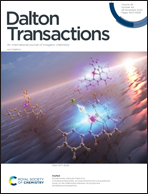Lanthanide functionalized MOF thin films as effective luminescent materials and chemical sensors for ammonia†
Abstract
In this work, a series of transparent luminescent MOF thin films are designed and prepared by assembling lanthanide functionalized UiO-67 (Ln(TTA/TAA)@UMOF, Ln = Eu, Tb, Er, Nd, TTA = 2-thenoyltrifluoroacetone, TAA = 1,1,1-trifluoropentane-2,4-dione) on organosilane linker (L) modified Al2O3 (A) using lanthanide ions as the bridge. Notably, Ln(TTA/TAA)@UMOF is synthesized by introducing lanthanide ions and TTA/TAA into the framework of the UMOF via a facile and non-destructive post-synthesis modification (PSM) strategy. Because there are multiple antennas including L, the ligand of UMOF, and β-diketone (TTA/TAA) transferring energy to lanthanide ions, these thin films exhibit excellent luminescence properties. Interestingly, the Eu@UMOF-Eu-LA film can selectively recognize ammonia without the interference of other indoor pollutant gases. Further investigation reveals that the Eu@UMOF-Eu-LA film sensor shows superior performances including quick response, outstanding selectivity and high sensitivity (LOD = 9 ppm) towards ammonia. These results illustrate that the Eu@UMOF-Eu-LA film has enormous potential to detect ammonia practically.



 Please wait while we load your content...
Please wait while we load your content...